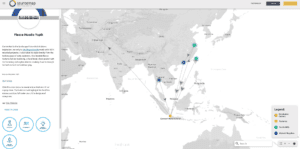Outerwear fit to fight climate change
When it comes to fighting climate change, every piece of clothing has a part to play. We switch up our normal clothing every day – and buy according to new trends. But that doesn’t count for outerwear.
People often own 3-4 coats and jackets, maybe 2 pairs of great sports pants, a pair of walking shoes – and these simply have to do the job. Outerwear needs to be durable and comfortable. Protecting people from the elements (we love a solid raincoat or windstopper here in The Netherlands).
But how can outerwear brands help protect the elements…from us?
We did the research for you. And analyzed 8 booming outerwear brands to see what they’re doing – to preserve the planet.
The brands:
- Vaude
- Patagonia (B corp)
- Cotopaxi (B corp)
- Decathlon
- Tentree (B corp)
- Northface
- Jack Wolfskin
- Napapijri
We found 3 main trends. Let’s dive in.
Trend #1. Responsible materials
All the brands we analyzed – focus on using responsible materials and suppliers for their products. ‘Responsible’ stands for socially and environmentally sustainable materials. Which choices stand out?
Ethical sourcing
Working conditions and social issues are a big problem in apparel. All brands commit to social responsibility in their supply chain – and transparently show how. Both Jack Wolfskin and Vaude commit to safety & fair living wages for all their workers, with their production sites frequently audited by Fair Wear. But there’s care about ethics for the animal kingdom too. Napaprij completely removed all fur and down from its products in 2016 ( animal products often have a large environmental impact too). And for the brands that haven’t – at least all have strict animal welfare policies.
Another way to ensure ethical sourcing – is knowing everything that goes on in your supply chain (preferably this includes environmental data and social efforts). And using the information to improve material sourcing and collaboration with suppliers. Napaprij created traceability maps on their products’ supply chains for exactly that purpose. We do love a transparent supply chain.

Low impact-materials
All brands on our list claim to use low-impact materials and/or ‘sustainable’ materials like organic cotton (even though not all of them show the data behind these claims…). We see two main trends in materials:
- PFC and PVC free.
PFCs are used for textile coating – mainly to make coats & jackets water and dirt-repellent. PVC is an incredibly durable plastic – which also means it stays in nature forever. Both materials are nearly indestructible and a big danger to our planet and human health. Three brands (Jack Wolfskin, Patagonia & Vaude) on our list already completely removed PFCs. And two (Jack Wolfskin & Vaude) almost completely removed PVC in their products.
- Recycle and reuse.
This covers the use of recycled and reused fabrics or materials in production processes. Which almost always results in a lower product footprint due to the prevention of producing new raw materials. Many of the brands have circular product series in which either they solely use recycled or reused materials – such as Cotopaxi’s (Re)Purpose® Collection. And/or create product lines that are easy to recycle. For example, Napaprijri’s circular series claims to use only one material type – which makes it optimal for recycling processes (easier to take apart).
*Beware: natural or sustainable materials often seem the sustainable option. But, alternatives sometimes require even more environment-intensive processes for production. Always measure the environmental footprint of materials – to prevent surprises.
Measuring the footprint of outerwear was never this easy with Mobius.
Read more about Mobius
Ecodesign
Ecodesign means using environmental data at every stage in your product’s lifecycle – to improve the environmental footprint of your products. Usually, gaining environmental data by performing Life Cycle Assessments (LCA) of products.
As credible environmental data becomes a must, so does Ecodesign. Decathlon embraces ecodesign to the core. Already having a 10.4% turnover in 2021 on ecodesigned products. And aiming for 100% product development with an eco-design approach by 2026.
Trend #2. Long and happy product lives
Producing products that stand the test of time – is great for both your environmental footprint as well as that of the apparel industry. It’s choosing quality over quantity. Making sure we prevent the production of new products. How do our brands embrace a long product life?
Repairs
Almost all brands on our list include free repairs in their customer service. Repairs are a great way to improve your environmental footprint: your customers don’t waste an (almost) good coat and unnecessarily buy something new. Some brands that deserve an extra shout-out are Patagonia, Decathlon, and Vaude. For example, Vaude and Patagonia offer great repair and DIY videos for small repairs – and a repair service for bigger repairs.
End-of-life product returns (circular program)
At least four brands, Patagonia, North Face, Cotopaxi, and Tentree – offer returns once consumers are done with their outerwear. They take responsibility for the whole product lifecycle – including the end of life. Doing so prevents outerwear products from ending up in landfills. And makes recycling and reuse possible. Tentree’s circularity program, enables customers to return their worn clothes for free. All clothing is either resold or recycled depending on the state. As a cherry on top – Decathlon even offers second-hand products. No waste at all!

Circularity by Tentree. Source: Tentree
Trend #3. Enabling sustainable decision-making (for customers)
Consumers drive business. This means they also hold the power to change business – if we enable them. Educating consumers on the social- and environmental footprint associated with their buys is a crucial aspect of a sustainable apparel industry. What do our brands do – to make consumers change their ways?
Communicating Sustainable benefits
Almost all brands disclose material use and benefits for the environment on their product overview pages. With Vaude and Patagonia paving the way in social and material transparency:

Patagonia’s material disclosure – with a clear ‘view impact’ button. Source: Patagonia.

Sustainable Usage tips
Brands sometimes forget how impactful the use of their products by consumers can be. Just think about the energy consumption of all the washing, drying, and ironing. In apparel this can make up to 25% of your product’s total footprint! To change consumer behavior, Patagonia and Vaude disclose tips on repairs and maintenance of your products.
Disclosing Product Environmental data
Decathlon discloses the carbon footprint of all its products (see image below). And provides a clear reference to what the footprint numbers represent. Due to increasing legislation like the European PEF method, disclosing environmental data becomes crucial. A trend expected to become even bigger in the next two years. Brands deciding to take their numbers out of their sustainability report and under their products – go bigger and bolder. Nice job Decathlon.

Decathlon’s product footprint disclosure beneath every product they sell. Source: Decathlon.
Conclusion
Overall we see supply chain and material transparency, a big focus on social responsibility, and extending product life. These are all great developments. However, with only Decathlon disclosing product footprints, there’s room for improvement in terms of environmental data disclosure.
How is your brand improving?
Understand the true environmental costs of your outerwear products. Calculate their environmental footprint and improve where it matters most – completely driven by data. Sounds good? Have a peek at our easy product LCA tool Mobius.

